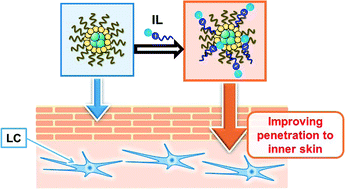Ionic liquid-mediated transcutaneous protein delivery with solid-in-oil nanodispersions†
Abstract
As a potentially safe and non-invasive vaccination method, transcutaneous immunization represents an attractive alternative to conventional vaccine delivery by injection. However, the development of transcutaneous immunization has remained a challenge for a large number of hydrophilic macromolecules including protein and peptide antigens. We report a novel ionic liquid (IL)-mediated transcutaneous vaccine formulation consisting of a solid-in-oil (S/O) nanodispersion of antigen coated with pharmaceutically accepted surfactants dispersed in IL-containing oil. The introduction of the IL [C12mim][Tf2N] (1-dodecyl-3-methyl imidazolium bis(trifluoromethyl sulfonyl) amide) as a penetration enhancer in the formulation significantly enhanced the skin permeability of ovalbumin (OVA), a model antigen. It was also found that the IL-mediated S/O nanodispersion obtained high levels of OVA-specific serum IgG compared with both S/O nanodispersions without IL and PBS control. These findings clearly indicate that ILs – which are potentially attractive “green” and “designer” solvents – could serve as potential skin penetration enhancers in transcutaneous vaccination for hydrophilic macromolecules.


 Please wait while we load your content...
Please wait while we load your content...